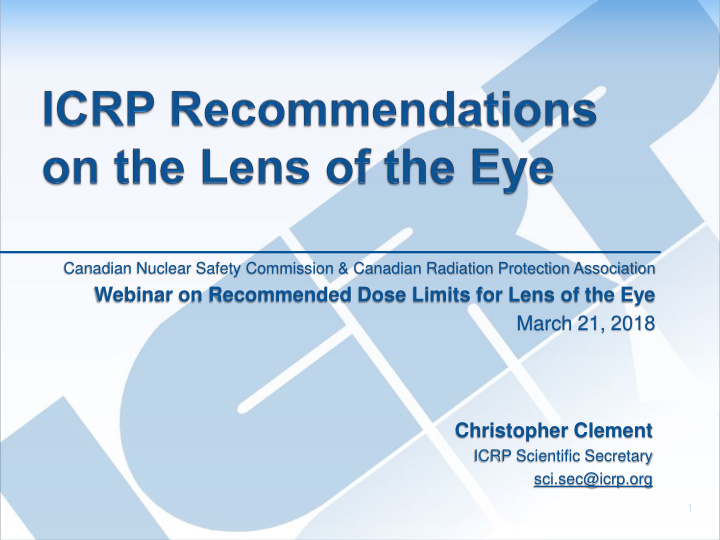



Canadian Nuclear Safety Commission & Canadian Radiation Protection Association Webinar on Recommended Dose Limits for Lens of the Eye March 21, 2018 Christopher Clement ICRP Scientific Secretary sci.sec@icrp.org 1
Advance for the public benefit the science of radiological protection , in particular by providing recommendations and guidance on all aspects of protection against ionising radiation 2
International Commission on Radiological Protection >250 members from 35 countries, experts who volunteer their time Independent Non-governmental Non-profit 3
ETHICAL SCIENCE EXPERIENCE VALUES SYSTEM OF RADIOLOGICAL PROTECTION 4
Contribute to an appropriate level of protection for people and the environment against the detrimental effects of radiation exposure without unduly limiting the desirable human actions that may be associated with such exposure 5
Manage and control exposures so that: Harmful tissue reactions (deterministic effects) are prevented Risks of cancer or heritable effects (stochastic effects) are reduced to the extent reasonably achievable 6
Cancer & Heritable Harmful Tissue Effects Reactions (Stochastic Effects) (Deterministic Effects) Probability Severity Additional Dose Additional Dose 7
Mechanism Cancer & Heritable Mutation of individual cells Effects (Stochastic Effects) Model for Protection Probability of effect increases with dose without threshold Probability Protection Aim Reduce risk to the extent reasonably achievable Additional Dose Keep doses As Low As Reasonably Achievable 8
Harmful Tissue Mechanism Reactions Injury to populations of cells (Deterministic Effects) Model for Protection e.g. necrosis, cataract induction, circulatory disease Severity of effect increases with dose above a threshold Severity Protection Aim Prevent harmful reactions Additional Dose Keep doses below threshold 9
ICRP Statement on Tissue Reactions & Early and Late Effects of Radiation in Normal Tissues and Organs – Threshold Doses for Tissue Reactions in a Radiation Protection Context 10
Report approved Initial plan to review tissue reactions ICRP Task Group 63 formed Report in development Consultation on report 2005 2006 2007 2008 2009 2010 2011 2012 Publication 118 Initial discussions at MC meeting Extensive discussions at MC meeting Active drafting of the statement Statement issued 11
Haematopoietic and immune systems Digestive system Reproductive system Skin Cardiovascular and cerebrovascular system Eye Respiratory system Urinary tract Musculoskeletal system Endocrine system Nervous system 12
Threshold for acute exposure: ~0.5 Gy with 95% CI including zero Threshold for protracted exposure: ~0.5 Gy Evidence mainly on opacities rather than cataracts because follow-up times were generally shorter Later study* from RERF: At 1 Gy, 20-30% excess of cataract surgery Threshold of 0 to 0.8 Gy, if one exists * Neriishi K, Nakashima E, Minamoto A, Fujiwara S, Akahoshi M, Mishima HK, Kitaoka T, Shore R: Postoperative cataract cases among atomic bomb survivors: Radiation dose response and threshold. Radiation Research 2007; 168:404-8 13
? Cancer & Heritable Harmful Tissue Effect Reaction (Stochastic Effect) (Deterministic Effect) Mutation of individual cells Injury to populations of cells No threshold Threshold Keep doses As Low As Keep doses below Reasonably Achievable threshold 14
Why? Harmful Tissue Previously considered Reaction tissue reaction (Deterministic Effect) Protection based on Injury to populations of cells assumption of a threshold still the best principle of protection for cataracts Threshold Therefore, aim to keep Keep doses below doses below threshold threshold 15
Dose Limits + Optimisation of Protection 16
“(3) For occupational exposure in planned exposure situations … equivalent dose limit for the lens of the eye of 20 mSv in a year, averaged over defined periods of 5 years, with no single year exceeding 50 mSv.” – Publication 118 Statement on Tissue Reactions Given the threshold, a higher limit would not be adequately protective Alignment with the effective dose limit facilitates implementation 17
“ (5) … protection should be optimised not only for whole body exposures, but also for exposures to specific tissues, particularly the lens of the eye … ” – Publication 118 Statement on Tissue Reactions Helps keep lifetime doses below threshold (annual limits alone do not guarantee this) Reflects uncertainty in setting threshold Accounts for the possibility of the lack of threshold 18
No change is recommended to the public dose limit for the lens of the eye (15 mSv per year) Existing limit remains adequately protective considering: the effective dose limit of 1 mSv/year low likelihood of protracted preferential exposure of the lens optimisation for exposures to the lens Although many options were considered, a change is not justified based on improvements to protection 19
No change to principles or concepts in the system of radiological protection Numerical change to the dose limit in response to clear evidence of a significantly lower threshold Explicit recommendation to optimise protection for exposures to the lens of the eye: Helps keep lifetime doses below threshold Reflects uncertainty in setting threshold Accounts for the possibility of the lack of threshold 20
21
www.icrp.org UK Registered Charity 1166304
Recommend
More recommend